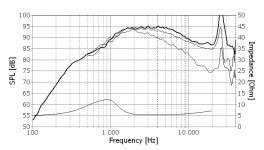Most speaker drivers have symmetrical Fs impedance peak but there are drivers (woofers and also tweeters) that have asymmetrical Fs impedance peak, which looks 'strange' intuitively if you saw many raw driver Fs impedances. What is the source of this and what are the realworld consequences (mainly audibility) of such an impedance? Thinking mainly about woofers where tipically using the drivers at it's Fs.
Examples of asymmetrical Fs peak:

https://sbacoustics.com/product/6in-sb17nrx2c35-8-norex/

https://www.seas.no/index.php?optio...xt&catid=45:seas-prestige-tweeters&Itemid=462
Examples of asymmetrical Fs peak:

https://sbacoustics.com/product/6in-sb17nrx2c35-8-norex/

https://www.seas.no/index.php?optio...xt&catid=45:seas-prestige-tweeters&Itemid=462
Compare these two tweeters:
Seas H1214 - no rear chamber, symmetric hump
Seas H1212 - rear chamber, skewed hump
I would think that the rear chamber of the tweeter causes the asymmetric impedance hump. The rear chamber is an add-on at the rear of the magnet and is connected to the original cavity directly below the dome, by means of a hole through the magnet, which is at least partly filled with foam. Now the guessing begins. The hole might behave somewhere between a resistance (foam) and an inductance (think of a bass reflex port). Together with the capacitance of the rear chamber, these would form a low pass filter. This partly blocks access to the rear chamber. This leaves two impedance humps: (1) one related to the original small cavity and (2) one related to the large rear chamber. These sum to a skewed hump. I think it has no real-world consequence.
As for the impedance hump of the woofer: this might be related to the foldover effect. If so, it would mean that the impedance measurement is taken at such a large level that something gets gets nonlinear. There is no direct real-world consequence, all woofers can be driven into nonlinearity.
Seas H1214 - no rear chamber, symmetric hump
Seas H1212 - rear chamber, skewed hump
I would think that the rear chamber of the tweeter causes the asymmetric impedance hump. The rear chamber is an add-on at the rear of the magnet and is connected to the original cavity directly below the dome, by means of a hole through the magnet, which is at least partly filled with foam. Now the guessing begins. The hole might behave somewhere between a resistance (foam) and an inductance (think of a bass reflex port). Together with the capacitance of the rear chamber, these would form a low pass filter. This partly blocks access to the rear chamber. This leaves two impedance humps: (1) one related to the original small cavity and (2) one related to the large rear chamber. These sum to a skewed hump. I think it has no real-world consequence.
As for the impedance hump of the woofer: this might be related to the foldover effect. If so, it would mean that the impedance measurement is taken at such a large level that something gets gets nonlinear. There is no direct real-world consequence, all woofers can be driven into nonlinearity.
Last edited:
Thanks TBTL! Of course all woofers can be driven into nonlinearity and probably the higher measuring level caused the resonance bending. SB Acoustics measures T/S parameters at 1V if I remember correctly, others may measures at lower voltage, but that means, the measured SB woofer goes significantly nonlinear even at 1V input. Higher tier SB drivers (Satori) doesn't show behaviour like this, so probably they are more linear at that level, which is not surprising.
That is weird, I would not expect significant nonlinearity at this level. This woofer has a copper cap, which suggests that attention has been paid to linearity.1V input
Well, every move of a woofer is nonlinear, just depends on what scale we inspect the things, IMO.
Look at the hificompass results, unfortunately there is no 1V input measurements, but at 2.83V the 20mm distance low frequency distortions (which comes from the excursion) is so much higher than in the midband (where it don't have to move much).
The Fs resonance also bends here, but differently than on the SB factory curve.(probably due to different input level)
https://hificompass.com/en/speakers/measurements/sbacoustics/sb-acoustics-sb17nbac35-8
Look at the hificompass results, unfortunately there is no 1V input measurements, but at 2.83V the 20mm distance low frequency distortions (which comes from the excursion) is so much higher than in the midband (where it don't have to move much).
The Fs resonance also bends here, but differently than on the SB factory curve.(probably due to different input level)
https://hificompass.com/en/speakers/measurements/sbacoustics/sb-acoustics-sb17nbac35-8
Sorry, wrong link in the previous comment, here is the SB17NRX2C35, the tendency is the same:
https://hificompass.com/en/speakers/measurements/sbacoustics/sb-acoustics-sb17nrx2c35-4
https://hificompass.com/en/speakers/measurements/sbacoustics/sb-acoustics-sb17nrx2c35-4